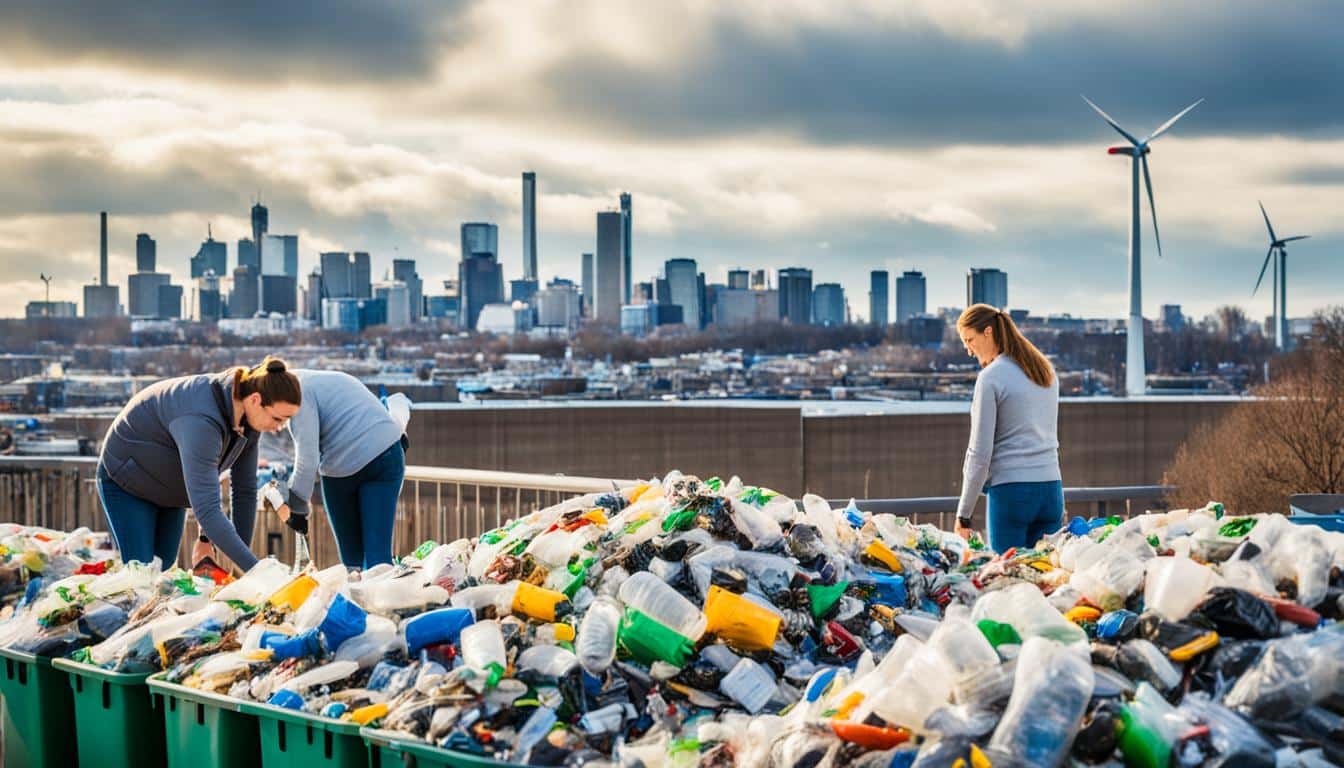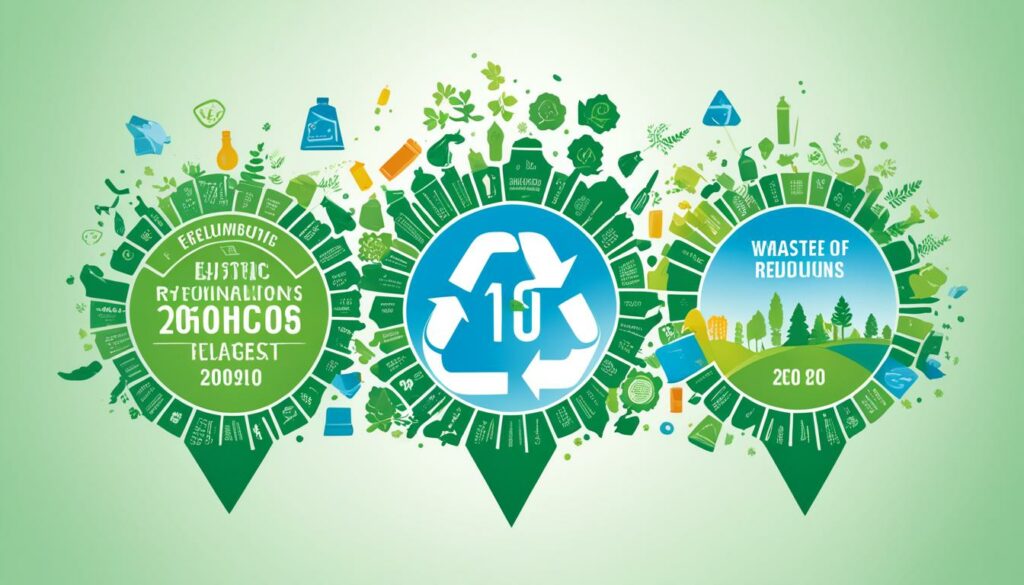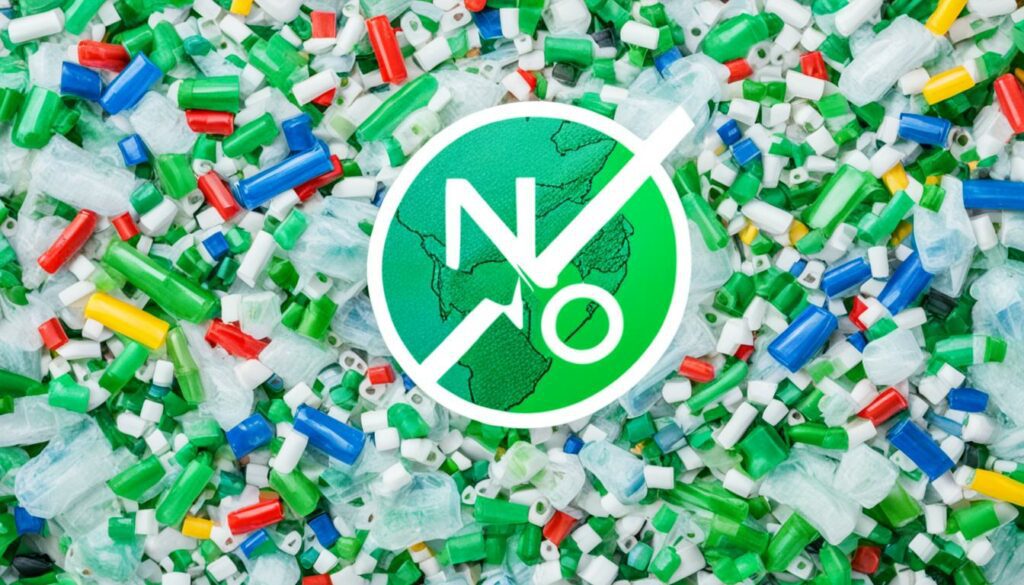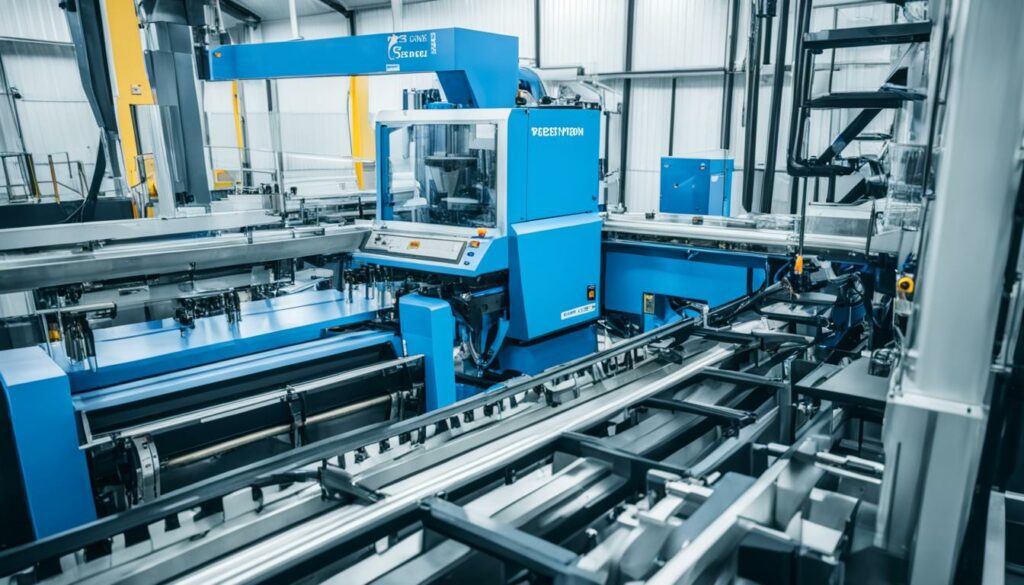Menu

Did you know that fishing gear and the top 10 single-use plastic items make up 70% of marine litter in the EU? This fact shows why we need strong rules on plastic waste. The European Parliament has acted. It has made new and strict rules to lower plastic waste and make packaging greener.
The EU’s new rules aim to lower the amount of packaging waste. They have set big goals: cut waste by 5% by 2030, 10% by 2035, and 15% by 2040. Each EU country has to work on using less plastic for packaging. The rules also say packaging should not have too much empty space. They want to make packaging lighter and smaller.
On 1 January 2030, several types of plastic packaging won’t be allowed. This includes packaging for fresh fruit and vegetables, single portions, small toiletry packs, and thin plastic bags. These changes are also made for health. Harmful PFASs cannot be used in food packaging because they are bad for the environment and people.
The EU is pushing for more reuse and refills. By 2030, shops must let people use their own cups and containers for drinks and food. Almost all packaging must be easy to recycle. They also set goals for using recycled plastic and collecting more plastic and metal containers for drinks.
Now, the European Commission are reviewing these steps for final approval. These actions are big for Europeans and the planet. They will change how we use and deal with plastic. These rules are part of a larger plan for a more sustainable future.
The European Union is tackling the growing problem of plastic waste. Since 2009, the amount of packaging waste has increased from 66 to 84 million tonnes in 2021. Every person added 188.7 kg to this waste in one year. This trend is expected to continue if nothing changes.
Over time, the EU has adapted its strategies to handle more packaging waste. The main goal is to make market rules consistent and promote the circular economy. Various waste prevention directives have been introduced. They seek to reduce plastic pollution and support sustainable growth.
In more recent times, the EU has set clear goals to improve how recycling works in its member countries. The focus is on lessening waste and sparking new, greener ideas. These efforts tie closely with the Circular Economy Action Plan, part of the European Green Deal. The aim is to make the EU’s economy greener, more competitive, and friendlier to consumers.
The EU has put in an extra €100 million to help make plastics easier to recycle. They also want to make recycling more efficient and remove harmful materials from the process. There are also new regulations to push more companies to use recycled plastic. This will drive the circular economy forward.
Important steps involve banning microplastics, regulating single-use plastic items, and improving facilities in ports to stop trash going into the sea. The EU has also worked on setting global guidelines and started a Europe-wide initiative to encourage better plastic waste handling. Altogether, these actions show the EU’s strong commitment to sustainable development under its new regulations.
The European Union is working hard to lessen plastic waste, marking sustainability targets for 2030, 2035, and 2040. It wants to cut down on plastic waste, mainly from packaging, because it harms our planet.

EU’s recycling legislation requires every EU country to hit a 55% recycling rate for regular waste and 65% for all packaging by 2025. Sadly, ten countries might not reach these goals, and 19 are struggling with a 50% target for plastic packaging recycling.
| Member State | Municipal Waste Target | Total Packaging Waste Target | Plastic Packaging Waste Target |
|---|---|---|---|
| Austria | Likely | Likely | Possible |
| Belgium | Likely | Likely | Possible |
| Czechia | Likely | Likely | Possible |
| Denmark | Likely | Likely | Possible |
| Germany | Likely | Likely | Possible |
| Italy | Likely | Likely | Possible |
| Luxembourg | Likely | Likely | Possible |
| Netherlands | Likely | Likely | Possible |
| Slovenia | Likely | Likely | Possible |
EU plans to reach even higher sustainability targets by 2030, making our world cleaner and greener. These goals for 2030, 2035, and 2040 show EU’s steady commitment to fighting pollution. They also give countries enough time to get ready and achieve these ambitions. Through such clear steps, the EU continues to be at the forefront of global efforts to protect our environment.
On 1 January 2030, full restrictions will apply to single-use plastics. These new rules are designed to cut down plastic waste. They prohibit plastic packaging types without good alternatives.
Items that you will not see include packaging for fresh fruit and vegetables. Also, small portions of condiments, mini toiletries, and thin plastic carrier bags. These laws aim to make packaging more eco-friendly and reduce plastic waste.
The EU is also targeting the most common single-use plastics. These make up 70% of litter in EU waters. The aim is for countries to collect 77% of plastic bottles separately by 2025. This must reach 90% by 2029.
The EU directive not only bans plastics but also points to eco-friendly alternatives. These include biodegradable items and those for more than one use. Businesses must switch to these options to follow the rules and stay green.
For instance, Electrolux Professional has a HeroDry technology. It dries up to 750 reusable cups an hour. This tech supports sustainability by reducing plastic waste.
The directive wants to cut down on single-use plastics through reusables. By 2030, 10% of drink packaging should be reusable. This is a big step in using fewer single-use plastics.
Working with suppliers is crucial for these eco-packaging laws. Together, they can find and use greener packaging. This collective effort aims to transform the market for the better. It will help build a stronger, green economy, meeting the law’s goals.
The EU aims for a greener future with its new recycling laws. These laws focus on using more recycled materials and setting strict rules for recyclable packaging. They are part of a bigger plan to move towards using resources in a more sustainable way.
All packaging must be easy to recycle, with a few exceptions. By 2029, plastic and metal drink containers should be collected for recycling 90% of the time. In Europe, only around one-third of plastic waste gets recycled, so there’s a lot of work left to do.

The EU wants packaging to have more recycled materials. It has set goals like having 25% recycled plastic in bottles by 2025. By 2030, the target is 30%. These goals are important because right now, recycled plastics meet only 6% of the demand in Europe.
Industries are being asked to use more recycled materials. This change is needed, especially as the amount of plastic being made has grown a lot. The EU also wants to cut down on exporting waste. Its goal is to recycle 55% of plastic packaging by 2030.
| Year | Recycled Content Target In Plastic Bottles | Packaging Waste Recycled |
|---|---|---|
| 2025 | 25% | — |
| 2029 | — | 90% (Single-use Plastic and Metal Beverage Containers Collection Rate) |
| 2030 | 30% | 55% |
These new laws aim to make packaging more sustainable. They hope to increase recycling while decreasing the harm to our planet. By following these regulations, we can make the European economy stronger and better for the environment.
For more information, refer to the European Parliament’s insights on plastic waste and recycling.
The new rules are all about getting people to reuse and refill more. They set goals for 2030, focusing on things like drink bottles and food containers. The EU wants to change how we buy things to cut down on trash and help the planet.
Shops that sell drinks and food to take away must let you use your own containers. By 2030, they should offer at least 10% of their products in containers that you can use again. This is to make the food industry less harmful to our planet and reduce the need for throwaway packages.
There are also goals for reusing stuff like drink bottles and boxes by 2030. These goals make sure businesses and shops are doing their bit for the planet. They hope to encourage everyone to reuse things more, cutting down on waste across Europe.
By 2029, almost all single-use drink and food containers should be recyclable. The aim is to collect 90% of these items to recycle separately. This big plan isn’t just about refilling and reusing. It’s also about teaching everyone the importance of recycling.
The main aim is to get us all living in a way that’s good for the earth. Encouraging refills and reuse is a big part of this goal. It means focusing on using less to protect our planet for the future.
New EU regulations mark a big change for the circular economy. They focus on preventing waste and pushing for green innovation. The goal is to make old ways of handling waste more efficient.

In March 2020, the European Commission rolled out its circular economy plan. This plan includes 35 actions. Its main aim is to encourage making products that last, help consumers make greener choices, and improve key industry impacts.
Key parts of the plan are cutting down waste shipments and reducing the use of dangerous chemicals. It also supports making better batteries and stopping the loss of plastic pellets. These steps aim to keep resources in the EU longer. They help cut down waste and use materials more wisely.
Innovative green ideas are crucial for the circular economy’s success. Since 2023, new ways to measure how well we use materials have been in place. This step shows the EU is serious about using tech to manage waste better.
In February 2021, the EU started the Global Alliance on Circular Economy and Resource Efficiency. This step shows the EU wants to lead global green efforts. These alliances push for new smart ways to manage waste. They want to change the idea that waste is something to throw away. Instead, they show how we can use it as a resource.
For the circular economy to work, we need to keep coming up with new ideas. Mixing these with big goals like fighting climate change is a must. This way, the EU can grow its economy in a way that is both sustainable and competitive.
Discussing health and safety in packaging, an essential part is controlling dangerous substances. The EU has released new rules on plastic waste, focusing on keeping consumers safe. It bans harmful chemicals like PFASs, known as “forever chemicals”.
These chemicals stay in the environment and can build up in our bodies, which is bad for our health. So, from 2026, PFAS will be banned in food packages over a certain amount.
Banning PFASs is a big health move. These bad chemicals can cause cancer and hurt our livers. By stopping these toxins from food packaging, the EU is aiming for better health for everyone. This plan is part of a global effort to fight the dangers of such harmful chemicals.
These plastic waste rules make manufacturers use safer things. It’s more than just avoiding bad chemicals. Everything, from how something is designed to when it’s thrown away, is about keeping people and the environment safe.
These rules mean using food-safe plastics that are checked and meet European laws. This makes food packaging safe and trustworthy.
Being so careful about health and safety wins over people’s trust. It makes them more sure that the products they use are safe. Plus, it’s good for the Earth, making our world less polluted and healthier for everyone.
The EU introduced new rules to cut down on plastic waste. A shocking 25% of Europe’s plastic waste ends up in landfills. This highlights how urgently we need to improve.

By 2030, the EU plans to recycle 55% of plastic packaging waste. This is a big jump from the current 6% in 2018. It shows the need for strong actions to support the environment.
There are new rules requiring minimum recycled content in some products. For instance, 25% of plastic bottles should be recycled by 2025. This number will increase to 30% by 2030. Such rules are key as the economy loses a lot when plastic isn’t reused.
There’s also a push to stop using lightweight plastic bags and other single-use plastics. The goal is to reduce litter in the sea. New port laws will make sure less plastic waste gets into the oceans.
Here’s a look at some important goals set by the EU for reducing plastic waste:
| Target | Current Level | 2025 Goal | 2030 Goal |
|---|---|---|---|
| Recycled Content in Plastic Bottles | 6% | 25% | 30% |
| Plastic Packaging Recycling Rate | Unknown | Unknown | 55% |
| Separate Collection for Plastic Bottles | Unknown | 77% | 90% by 2029 |
| Reduction of Plastic Waste Landfilled | 25% | Unknown | Significant Reduction |
Moreover, a directive is in place to cut plastic pollution from single-use items. It will lead to a cleaner environment. There’s also €100 million set aside for developing better plastic options.
This effort links with the EU’s plan for a Circular Economy. It will help the EU become carbon-neutral and competitive. By taking these steps, we can steadily decrease plastic’s harm on our environment.
The European Green Deal is key in the EU’s efforts on the global environmental front. It works with plastic waste policies. This shows the EU wants a circular economy. It aims to reduce emissions and protect the ecosystem. The deal will change how all industries work.
The European Green Deal works to better recycle plastic, follow a circular economy, and cut down plastic’s harm. It wants to recycle 55% of plastic packaging by 2030, which is way up from today’s 30%. So far, almost a third of plastic waste in Europe gets recycled, a big step forward.
Teaming up with the European Green Deal boosts the EU’s push for a sustainable future. It focuses on cutting plastic waste and lowering greenhouse gas emissions from plastic. The world could see plastic’s emissions go up to 2.8 billion tonnes by 2050. Better recycling could really make a difference.
| Year | Plastic Waste Recycled (%) | Recycled Content in Plastic Products (%) | GHG Emissions from Plastic (Million Tonnes) |
|---|---|---|---|
| 2018 | 30% | 6% | 850 |
| 2030 (Target) | 55% | 25% | Potentially Reduced |
| 2050 (Projections) | – | – | 2.8 Billion |
Linking plastic waste work with the European Green Deal marks a big move towards a better future. This sets environmental rules for all EU countries. It brings everyone together to tackle big global environmental issues.
The EU is enforcing new rules to reduce plastic waste. This means companies have to change how they operate. They must use less packaging, more recyclable materials, and drop some single-use plastics. For smaller businesses, meeting these demands can be tough without big resources.

Industries are busy reorganising to follow the new rules. They need to invest in new, recyclable plastics. Since 2018, the EU has put over €100 million into better plastic use. Businesses are now encouraged to make recyclable and recycled content for their products.
Small businesses, known as micro-enterprises, get help to cope with the changes. The rules offer special exceptions and more time to get ready. The goal is to make sure all companies, no matter their size, can join in. This helps the whole community work towards a better, less wasteful future.
The European Union is leading the way in dealing with plastic waste. It targets a 70% reduction in single-use items. This is great for our oceans and the life that depends on them.
In January 2018, the EU began its important plastics strategy. It tackles environmental and climate change issues head-on. By using eco-friendly plastics and improving how we clean up litter, the EU plans to cut marine litter.
Moving to green packaging is a big change for businesses. There might be costs at first. But, in the long run, companies will save money. The EU is putting €100 million towards this green future. This will create jobs and help our economy.
With new rules pushing for better recycling, companies will grow. They will meet global standards and help the environment too. The EU’s goals are in line with big world plans to fight climate change and grow sustainably.
The EU aims to revolutionise the packaging industry. Here are their big goals for the near future:
| Target Year | Objective |
|---|---|
| 2025 | 77% separate collection of plastic bottles |
| 2029 | 90% separate collection of plastic bottles |
| 2030 | 30% recycled content in new plastic beverage bottles |
Consumer habits are changing to be more eco-friendly. This comes from recent laws making people more aware. More than 4 out of 5 people worldwide are very worried about plastic in the sea.
These concerns are also shown in how people buy things. About 54% of shoppers look for brands that help the environment.
In the U.S., nearly half the people are trying to use less plastic, especially after the pandemic. Also, 80% want to buy products that aren’t wrapped in single-use plastic. Many Americans think it’s important for items to have green labels when they shop.

This push can also be seen in the UK. Here, 71% want beauty and personal care products to be more friendly to the planet. Brands that meet this wish are doing better in the market.
Products that are seen as good for the earth are becoming more popular. They are growing in sales 5.6 times faster than others. This shows how much people’s shopping habits are changing.
It’s not just about what we do as single people. Reducing plastic waste has become a wider effort. Large campaigns, such as those by Consumers International, have gotten over 31 million people involved. World Consumer Rights Day 2021 was a big success because of this.
Together, we can push for laws that help the earth. This way, we can reach big environmental goals.
The EU is making big steps towards better waste management with new packaging rules. These rules are likely to change and improve over time. They will help tackle new industry problems with a focus on the environment.
After these rules start being used, we will likely see some changes. Companies will have to find new ways to package products to cut waste. They’ll need to hit certain goals, like reducing waste by 10% by 2030.
This means we might see more recycling in packaging and new types of materials used. The idea is to use less and create less waste over the years.
The EU has big dreams for how we handle waste in the future. It wants 90% of packaging materials to be recycled by 2029. After that, it will look into setting eco-friendly rules for certain types of plastics.
The aim is to reduce the huge amount of packaging waste we produce. This was 84 million tonnes just in 2021. The goal is to make our environmental policy stronger over time.
These new rules aren’t just about being good for the planet. They also want to help the economy and spur new ideas. With more packaging being used, everyone has to work together to make sure it doesn’t hurt the Earth. This is essential for a sustainable future in Europe.
The EU has set new targets to cut down on packaging waste. They plan to do this by 2030, 2035, and 2040. The goal is to greatly reduce plastic packaging waste.
The past approach was reacting to more and more packaging waste. They wanted to make market rules match and promote recycling. The new EU packaging directive continues these efforts by pushing for better recycling and less waste.
The main aims are to cut waste, make packaging lighter and smaller, and to ban some plastic packaging. The EU also wants all packaging to be easy to recycle. These steps will help the environment and promote recycling.
The EU wants to see a 5% drop in packaging waste by 2030. By 2035, they aim to reduce it by 10%, and by 2040, by 15%. These goals help push countries to work on reducing waste regularly.
From 1st January 2030, some plastic packaging will be banned. This includes packaging for some foods, single-use personal care products, and thin plastic bags. PFASs, used in food packaging, will also be phased out for safety reasons.
The rules promote using things that can easily break down, can be used again, or are new and good for the planet. These options are to replace the banned plastic items.
By 2029, most single-use packaging should be collected for recycling 9 out of 10 times. Also, certain packaging must have a bit of recycled material in it already. These rules are aiming to better the recycling system.
By 2030, shops will have to offer ways for customers to re-use or fill up their own containers for some products. At least 10% of these products should be placed in reusable packaging.
The rules push new ways to manage waste that are better for business and the earth. They aim to keep materials in use longer and up recycling rates. This is key to the EU’s plan for a circular economy.
There’s a big step to stop dangerous chemicals getting into food packaging. PFASs, which stay a long time in nature and might be bad for people, will be stopped. This is to keep food packages safe.
These rules are part of the EU’s bigger plan to cut down on waste, prevent pollution, and keep the natural world safe. Getting rid of plastic waste is a major part of this effort.
Making less packaging, more recyclable packaging, and moving away from certain plastics can be tough for businesses. Smaller companies might find it harder, but there are rules to help them change.
These rules should greatly cut down on the plastic that ends up in the sea. There might be some costs at first for changing how things are made and recycled. But, it will also make new markets for green packaging solutions.
Businesses will need to help people use things again and learn about the harm of waste. This will hopefully make people choose more eco-friendly habits.
After these rules are in place, there will be more changes in the future. They will base these changes on how the industry adapts. The long-term goal is to produce less waste, recycle more, and have people use things in a sustainable way.